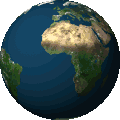|
Northern Western
Europe 
Iceland

REYKJAVIK 
Iceland is a Nordic island country in the North Atlantic,
with a population of 358,780 and an area of 103,000 km2, making it the most sparsely populated country in Europe 
Iceland is volcanically and geologically active.  The capital and largest city is Reykjavík. With Reykjavík and the surrounding areas in the southwest of the country being home to over two-thirds of the population. 
The word "Ísland/Island" in Nordic languages is literally translated to English as its name "Iceland" and should not be confused with the word island. 
Iceland is warmed by the Gulf Stream and has a temperate climate, despite a high latitude just outside the Arctic Circle. The interior consists of a plateau characterised by sand and lava fields, mountains, and glaciers, and many glacial rivers flow to the sea through the lowlands. 
 Reykjavik is located in southwestern Iceland, on the southern shore of Faxafloi bay.  Reykjavik is believed to be the location of the first permanent settlement in Iceland, which, according to Landnamabok, was established by Ingolfr Arnarson in AD 874.  Until the 19th century, there was no urban development in the city location.  The city was founded in 1785 as an official trading town and grew steadily over the following decades, as it transformed into a regional and later national centre of commerce, population, and governmental activities. It is among the cleanest, greenest, and safest cities in the world.  The Reykjavik area coastline is characterized by peninsulas, coves, straits, and islands.  Harpa is a concert hall and conference centre in Reykjavik. 30.05.2019.  The building features a distinctive colored glass facade inspired by the basalt landscape of Iceland.  Harpa was designed by the Danish firm Henning Larsen Architects in co-operation with Danish-Icelandic artist Olafur Eliasson.  The structure consists of a steel framework clad with geometric shaped glass panels of different colours.  Iceland Reykjavik, 30.05.2019.  Iceland Reykjavik, 30.05.2019.  Iceland Reykjavik, 30.05.2019.  Iceland Reykjavik, 30.05.2019.  Iceland Reykjavik, 30.05.2019.  Iceland Reykjavik, 30.05.2019.  Iceland Reykjavik, 30.05.2019.  Iceland Reykjavik, 30.05.2019.  Iceland Reykjavik, 30.05.2019.  Iceland Reykjavik, 30.05.2019.  Iceland Reykjavik, 30.05.2019.  Iceland Reykjavik, 30.05.2019.  Iceland Reykjavik, 30.05.2019.  Iceland Reykjavik, 30.05.2019.  Iceland Reykjavik, 30.05.2019.  Iceland Reykjavik, 30.05.2019. 
Iceland Reykjavik Hallgrímskirkja may 2019
 Hallgrímskirkja is a Lutheran (Church of Iceland) parish church in Reykjavík. It is the largest church in Iceland and among the tallest structures in the country.  The church is named after the Icelandic poet and clergyman Hallgrímur Pétursson (1614–1674), author of the Passion Hymns.  Situated on a hilltop near the centre of Reykjavík, the church is one of the city's best-known landmarks and is visible throughout the city.  State Architect Guðjón Samúelsson's design of the church was commissioned in 1937. He is said to have designed it to resemble the trap rocks, mountains and glaciers of Iceland's landscape. The design is similar in style to the expressionist architecture of Grundtvig's Church of Copenhagen, Denmark, completed in 1940.  Hallgrímskirkja Iceland Reykjavik, 31.05.2019.  Hallgrímskirkja Iceland Reykjavik, 31.05.2019.  Iceland Reykjavik, 31.05.2019.  Iceland Reykjavik, 31.05.2019. 
The Blue Lagoon Grindavík on the Reykjanes Peninsula may 2019
The Blue Lagoon is a geothermal spa in southwestern Iceland.  The spa is located in a lava field near Grindavík on the Reykjanes Peninsula, in a location favourable for geothermal power, and is supplied by water used in the nearby Svartsengi geothermal power station.  The water's milky blue shade is due to its high silica content. Blue Lagoon, 31.05.2019.  The silica forms soft white mud on the bottom of the lake which bathers rub on themselves. The water is also rich in salts and algae.  The water temperature in the bathing and swimming area of the lagoon averages 37-39 °C  The lagoon is man-made. The water is a byproduct from the nearby geothermal power plant Svartsengi where superheated water is vented from the ground near a lava flow and used to run turbines that generate electricity.  After going through the turbines, the steam and hot water passes through a heat exchanger to provide heat for a municipal water heating system. Then the water is fed into the lagoon.  The rich mineral content is provided by the underground geological layers and pushed up to the surface by the hot water used by the plant.  Because of its mineral concentration, water cannot be recycled and must be disposed of in the nearby landscape, a permeable lava field that varies in thickness from 50 cm to 1 m.  After the minerals have formed a deposit, the water reinfiltrates the ground, but the deposits render the ground impermeable over time, so the plant needs to continuously dig new ponds in the nearby lava field.  The water renews every 2 days. The average pH is 7.5 and the salt content is 2.5%. Very few organisms live in the water apart from some blue-green algae, despite the water not being artifically disinfected it contains no fecal bacteria, environmental bacteria, fungi, or plants  Iceland Blue Lagoon, 31.05.2019.  Iceland Blue Lagoon, 31.05.2019.  Iceland Blue Lagoon, 31.05.2019.  Iceland Blue Lagoon, 31.05.2019.  Iceland Blue Lagoon, 31.05.2019.  Iceland Blue Lagoon, 31.05.2019.  Iceland Blue Lagoon, 31.05.2019.  Iceland Blue Lagoon, 31.05.2019.  Iceland Blue Lagoon, 31.05.2019.  Iceland Blue Lagoon, 31.05.2019.  Iceland Blue Lagoon, 31.05.2019. 
 
|




















